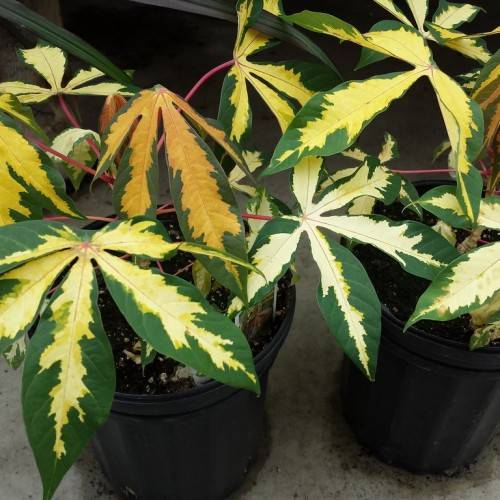
bitter cassava
Manihot esculenta 'Variegata'
Cycle:
Perennial
Watering:
Average
Hardiness Zone:
10 - 12
Flowers:
Flowers
Sun:
Full sun,part shade
Leaf:
Yes
Growth Rate:
Low
Maintenance:
Moderate
Salt Tolerant:
Yes
Care Level:
Medium
watering
Bitter cassava (Manihot esculenta 'Variegata') needs to be kept well watered. During the growing season, you should water the plant about once a week, making sure to check the top layer of soil to make sure it isn't too dry. During the hottest months, you may want to increase watering frequency to once every 4 to 5 days. Make sure that the soil is evenly moist throughout your container, and allow excess water to drain away before placing the container back into its usual spot. During the winter months, reduce watering frequency slightly but ensure to keep the soil mostly moist. You should water the plant about once every 2 weeks throughout the cooler winter months. Take care not to over-water the plant during the winter months as this could cause root rot and other health issues.
sunlight
Bitter cassava (Manihot esculenta 'Variegata') prefers full sunlight. It can tolerate partial shade but will grow the best with at least 6 hours of direct sunlight each day. If the plants are not receiving enough sunlight, new growth will be slow and the leaves may be smaller or pale in color. Sunlight during the morning hours is ideal as this helps the plant to produce the sugars it needs for energy. It is also important to make sure the plant is not in an area that is too hot or exposed to extreme afternoon sun, as this could lead to wilting and other issues.
pruning
Bitter cassava (Manihot esculenta 'Variegata') should be pruned twice a year, in late winter and late summer. In late winter (February to March), the bitter cassava plant should be pruned to remove all dead or dying stems and promote new, healthy growth. During late summer (August to September), cassava should be pruned to maintain a desirable shape, remove any poor-quality stems, and remove any stems that are likely to interfere with other plants. Pruning should be moderate in that the plant should retain its overall shape and be pruned back no more than 1/3 of the total plant height. Additionally, all pruned material should be disposed of away from the plant.
